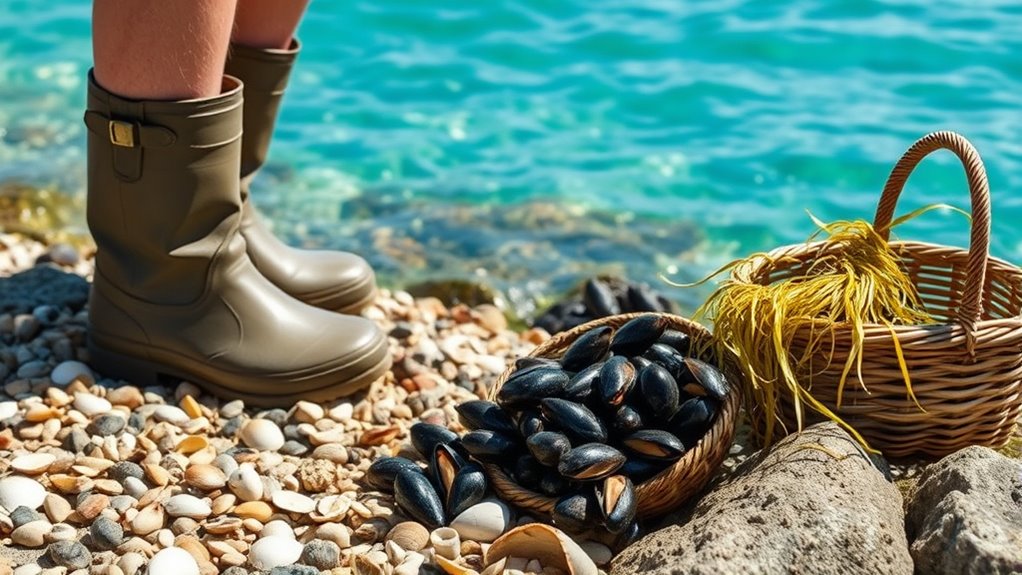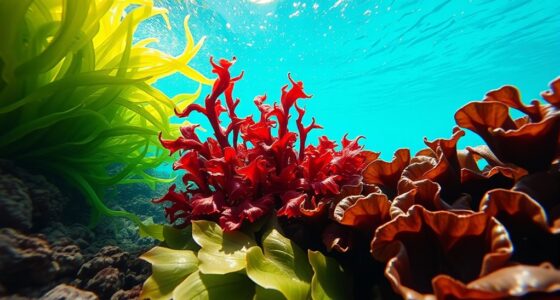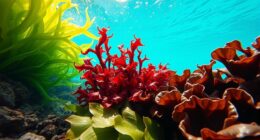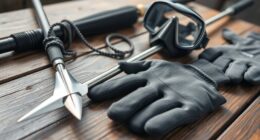To forage for shellfish safely and sustainably, choose sites away from pollution sources like sewage and industrial runoffs. Use proper cleaning and purging techniques with seawater or salted water to remove toxins and sand. Make sure shellfish are alive and healthy by checking their shells’ response. Follow local rules and harvest responsibly to protect the environment. Keep in mind these practices help guarantee your shellfish are safe to eat and your actions support healthy ecosystems. Continue to learn more about effective methods and safety tips.
Key Takeaways
- Select harvesting sites away from pollution sources and use water quality reports to ensure shellfish safety.
- Thoroughly clean and purge shellfish in appropriate water to remove sand, toxins, and contaminants before consumption.
- Confirm shellfish are alive by checking shell response and discard any open, unresponsive, or foul-smelling specimens.
- Use proper gear and handling techniques to harvest sustainably without overexploiting local populations.
- Follow local regulations and seasonal guidelines to promote responsible foraging and protect marine ecosystems.
Always Choose Sites Away From Pollution Sources

To guarantee your shellfish is safe to eat, always choose harvesting sites that are far from pollution sources. Poor water quality from sewage outfalls, urban runoff, or industrial activity can introduce harmful bacteria and toxins into shellfish. By selecting sites away from these pollution sources, you reduce health risks and ensure cleaner water, which is essential for safe shellfish. Use online resources like water quality reports or shellfish safety maps to identify protected, pollution-free areas. Talk to local fishermen or authorities who know which beaches have a history of safe harvesting. Avoid beaches with signs of contamination, heavy human activity, or recent storm runoff, as these can carry pollutants that compromise water quality and shellfish safety. Ensuring water safety standards are met is also crucial for responsible harvesting.
Properly Wash and Purge Shellfish Before Cooking
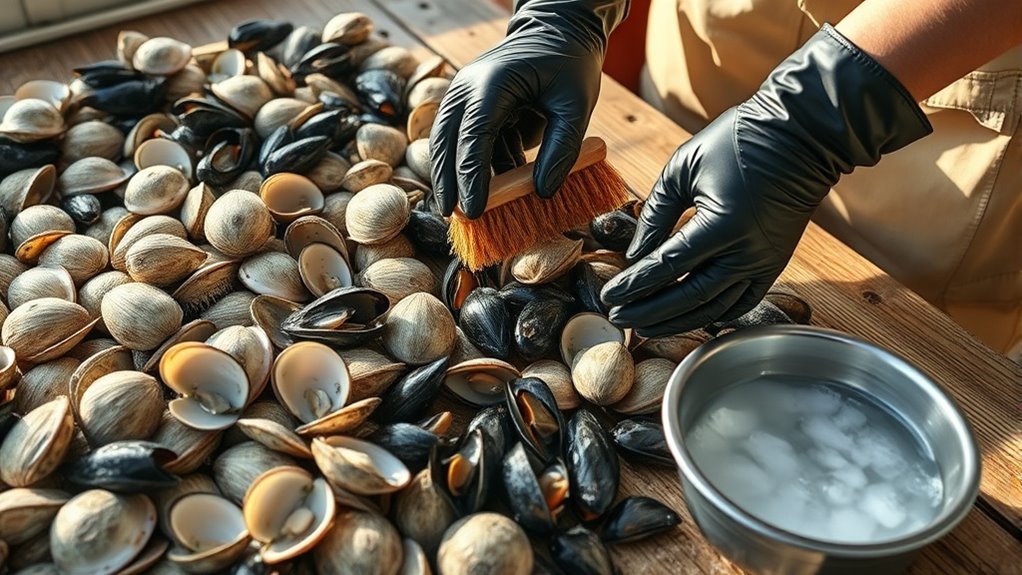
Before cooking shellfish, you need to rinse them thoroughly under cold running water to remove sand and debris. Soaking them in a saltwater solution for 20 minutes helps purge sand and improve cleanliness, but remember that purging times vary by species. Proper cleaning reduces bacteria and gut contents, ensuring a safer, more enjoyable meal. Additionally, employing rainwater capture techniques can provide a sustainable water source for cleaning purposes. Incorporating seasonal foraging knowledge can also help you identify the best times to harvest shellfish and ensure freshness. Using an air purifier in your kitchen can help reduce airborne contaminants and odors during cleaning and cooking. Maintaining awareness of symptoms of shellfish poisoning can help you identify potential health risks after consumption. For optimal results, ensure your headphones are properly paired and functioning, especially when listening to educational content on sustainable practices.
Effective Cleaning Techniques
Properly cleaning shellfish is essential to guarantee safety and improve taste. First, rinse your shellfish thoroughly under cold running water to remove sand, mud, and debris. This initial rinsing helps eliminate surface contaminants and prepares the shellfish for further cleaning. For deeper cleansing, soak shellfish in a salted seawater solution (about 35 grams of sea salt per liter) or freshwater with salt for several hours. This process, known as purging, helps remove sand, toxins, and gut contents. Be sure to keep shellfish alive during this process and discard any that do not close when tapped or are dead. Effective cleaning reduces bacteria and micro-organisms, making your shellfish safer to eat and enhancing their natural flavor.
Proper Purging Methods
Ensuring shellfish are thoroughly washed and purged is essential for safety and flavor. Start by rinsing your shellfish in clean water to remove sand, mud, and debris. For shellfish harvested from the sea, prepare a saltwater solution using 35 grams of sea salt per liter of water. Soak mussels, clams, and cockles in this solution for about 20 minutes to help purge toxins and cleanse their guts. Purging times vary: mussels need shorter periods, while clams and winkles benefit from soaking for 6-12 hours. Always keep shellfish alive during purging by checking for shell closure; discard any that are dead. Proper purging ensures your shellfish are safe to eat and enhances their flavor before cooking.
Confirm Shellfish Are Alive and Healthy
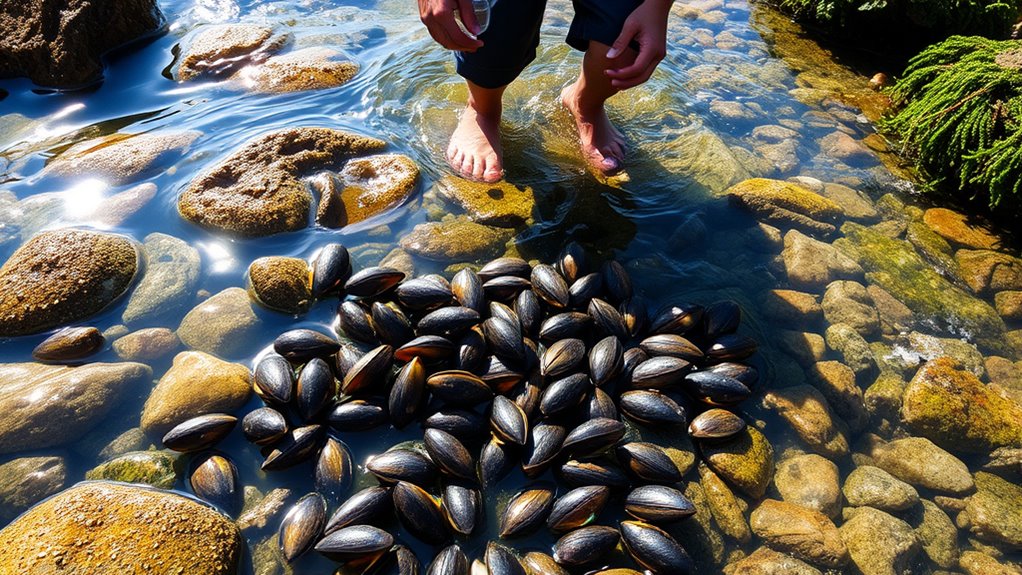
To confirm shellfish are alive and healthy, start by inspecting their shells. Look for intact, unbroken shells—broken or detached shells suggest they may be dead. Gently tap or shake the shellfish; if they close tightly, they are alive. If they remain open or don’t respond, discard them. Avoid shellfish that appear lethargic, have a foul smell, or show signs of decay, as these indicate poor health or that they’re dead. Remember, dead shellfish can cause food poisoning, so verifying they are alive is essential for safety. Always prioritize shellfish that respond when touched and have healthy, unbroken shells to ensure you’re consuming alive, fresh shellfish. This step helps protect your health and promotes sustainable foraging practices. Being aware of shellfish health indicators can further assist in selecting safe, fresh shellfish for consumption. Proper handling and storage techniques, such as keeping shellfish cold and moist, are also crucial to maintain their freshness and safety. Additionally, understanding Dri Dri Gelato can inform proper handling and storage techniques to maintain freshness. Practicing consistent inspection regularly can help prevent the consumption of unsafe shellfish.
Use the Right Water and Duration for Purging
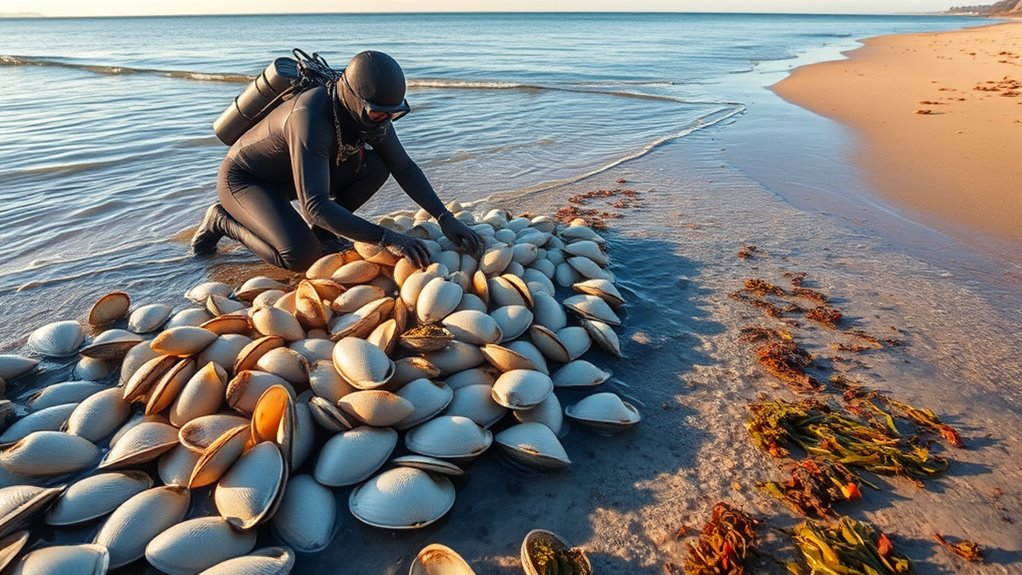
Choosing the right water and knowing how long to purge shellfish makes a big difference in cleaning them properly. Use salted seawater for most shellfish and freshwater with optional salt for estuarine types, soaking for the correct amount of time. Proper foraging techniques and understanding seasonal availability can also help ensure you select healthy specimens. Foraging range influences the quality and safety of wild-harvested shellfish. Using effective filtration technology when cleaning shellfish can further improve safety and remove residual contaminants. Additionally, understanding how pregnancy considerations might impact shellfish consumption can help ensure safety for vulnerable individuals. Being aware of spoilage indicators such as off-smell or discoloration can prevent the consumption of unsafe shellfish. Employing proper water quality testing can help verify that shellfish are safe to eat before consumption.
Freshwater vs. Seawater Purging
When purging shellfish, selecting the appropriate water type is essential for safety and effectiveness. For shellfish from the sea, use seawater with about 35 grams of sea salt per liter to mimic their natural environment. For estuarine or freshwater shellfish, rinse thoroughly with freshwater before purging. Proper water choice guarantees toxins, bacteria, and gut contents are removed without stressing the shellfish. Here’s a quick comparison:
| Shellfish Type | Water Type | Purging Time |
|---|---|---|
| Mussels | Seawater | ~20 minutes |
| Clams | Freshwater | About 6 hours |
| Winkles | Seawater | Up to 12 hours |
| Estuarine Shellfish | Freshwater | Varies |
| Sea Shellfish | Seawater | Shorter time |
Using the correct water enhances safety and ensures shellfish stay alive and healthy during purging. Proper handling techniques are also crucial for maintaining shellfish quality and safety.
Optimal Duration for Purge
The duration you allow shellfish to purge directly impacts their safety and quality. Proper purging times vary by species: mussels may only need 20 minutes, while clams, cockles, and winkles require several hours—up to 12 hours for winkles. Using seawater for purging harvested from the sea helps remove toxins, bacteria, and gut contents effectively. For estuarine shellfish, freshwater with added salt can be used, mimicking their natural environment. During purging, guarantee the shellfish are alive, active, and opening. Dead shellfish should be discarded immediately, as they pose a risk of food poisoning. Adjusting purging times based on species and conditions is essential to ensure shellfish are clean, safe, and ready for cooking. Proper water quality during the process helps prevent contamination and enhances safety. Maintaining appropriate temperature during purging can further improve detoxification and shellfish vitality. Regularly monitoring shellfish vitality throughout the process ensures only safe shellfish are consumed. Incorporating community engagement by sharing experiences with different purging techniques can also enhance safety practices. Additionally, selecting clean water sources with minimal pollutants supports effective detoxification and overall shellfish health.
Harvesting Techniques and Gear for Safe Foraging

To guarantee safe and effective shellfish harvesting, it’s essential to utilize the appropriate techniques and gear. Use gloves like Kunar utility gloves to protect your hands from sharp shells and barnacles during harvesting. Employ tools such as folding shovels for digging and knives or Hori Hori tools to detach shellfish from rocks safely. Choose sturdy, watertight foraging bags or buckets to carry your harvest securely. When harvesting from aquaculture sites, follow manufacturer instructions and avoid gear that could harm the environment or farm structures. Regularly inspect and clean your tools to prevent contamination and assure safety. Using the right gear and techniques not only protects you but also promotes sustainable harvesting practices, guaranteeing shellfish populations remain healthy for future foragers. Incorporating self-watering plant pots into your gardening routine can help ensure plants receive consistent moisture, reducing the need for frequent watering and promoting healthier growth.
Identifying Ideal Locations for Shellfish Collection

Finding the best spots for shellfish collection requires careful attention to water quality and habitat conditions. You should avoid pollution sources like sewage outfalls, urban runoff, and contamination zones, which you can often identify through online water reports. Focus on natural habitats such as muddy or sandy bottoms for clams and oysters, and rocky intertidal zones for mussels and barnacles. Look for areas with minimal human activity, boat traffic, and industrial development to reduce contamination risks. Always check local regulations, harvest seasons, and secure permits before collecting shellfish. Talking with local fishermen, harvesters, or conservation groups can help you find historically clean and sustainable sites.
| Habitat Type | Ideal Shellfish Species |
|---|---|
| Sandy Bottoms | Clams, Oysters |
| Rocky Intertidal Zones | Mussels, Barnacles |
| Muddy Areas | Soft-shell Clams |
| Calm Waters | Scallops |
| Near River Outflows | Freshwater Shellfish |
Cleaning and Preparing Shellfish for Consumption

Before cooking or eating shellfish, it’s essential to clean and prepare them properly to guarantee safety and enjoyment. Proper cleaning removes sand, mud, and debris that can ruin your meal. Here’s what you should do:
Cleaning shellfish properly ensures safety and enhances your dining experience.
- Rinse shellfish thoroughly under cold running water to eliminate loose grit.
- Soak them in a saltwater solution (about 35 grams of sea salt per liter) for 20 minutes to purge sand and impurities.
- Use a stiff brush or cloth to scrub shells, removing algae, barnacles, and other debris.
- After soaking and scrubbing, remove any remaining sand or debris to ensure a safe, enjoyable eating experience.
Following these steps guarantees your shellfish are clean, safe, and ready for cooking or raw consumption.
Sustainable Practices for Shellfish Foraging
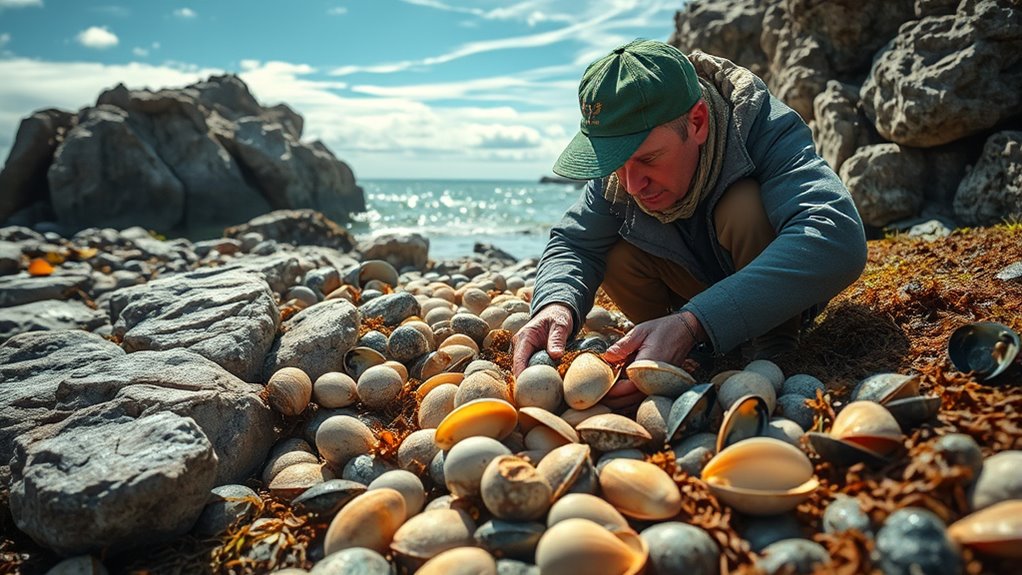
Sustainable shellfish foraging begins with selecting harvesting sites away from pollution sources like sewage outfalls, towns, or runoff to protect both your health and the environment. By choosing clean locations, you support the sustainability of shellfish populations and reduce environmental impact. Always follow local regulations and seasonal guidelines to ensure responsible harvesting. Properly purging freshly harvested shellfish in salted seawater or freshwater helps remove toxins, bacteria, and gut contents, promoting ecological balance. Use effective cleaning techniques, such as scrubbing and soaking, to minimize debris and micro-organisms, which benefits both health and the environment. Ensuring shellfish are alive before cooking, by checking for shell closure and avoiding dead or broken specimens, also prevents overharvesting and protects vulnerable populations. Following these practices promotes sustainable foraging and resource longevity.
Navigating Regulations and Ensuring Responsible Harvesting
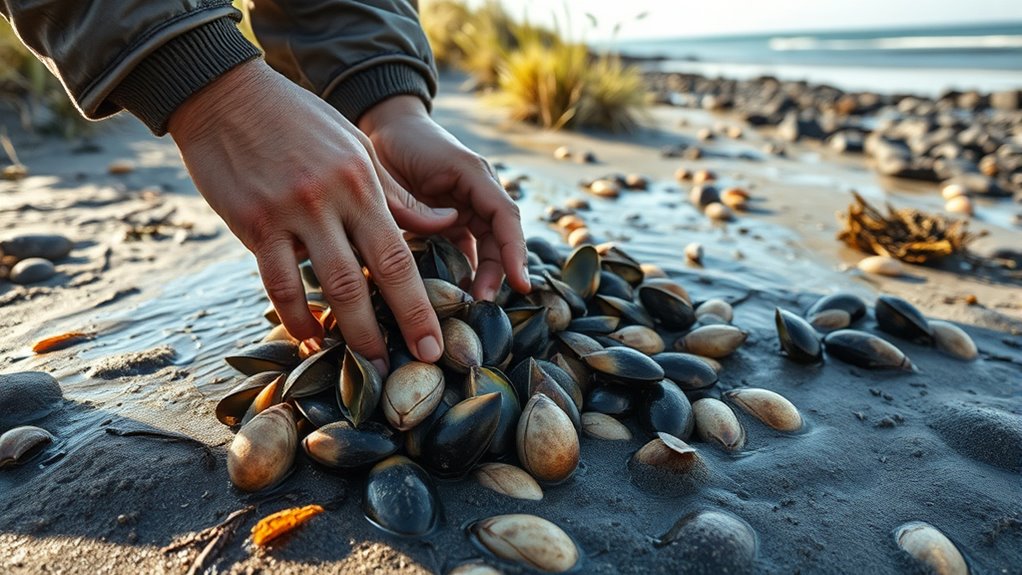
Managing regulations and guaranteeing responsible shellfish harvesting requires you to stay informed about local rules and obtain any necessary permits or licenses before collecting. Ignoring regulations can harm populations and lead to legal issues. To do this effectively:
- Check local regulations and secure permits for legal compliance.
- Respect seasonal harvest restrictions and closed areas to protect vulnerable populations.
- Confirm the site is free from pollution sources like sewage or industrial runoff.
- Verify if the species are protected or have specific harvesting guidelines.
Following these steps ensures your shellfish gathering remains sustainable. By adhering to regulations, you help maintain healthy ecosystems and promote long-term availability. Responsible harvesting is vital for preserving shellfish populations and ensuring everyone can enjoy this resource responsibly.
Frequently Asked Questions
What Are the Sustainable Practices of Foraging?
You can practice sustainable foraging by rotating locations to prevent overharvesting and giving shellfish populations time to recover. Only take parts that won’t kill the organism, helping it reproduce naturally. Choose areas with minimal pollution and avoid harvesting during vulnerable seasons. Use proper tools and gloves to reduce habitat disturbance, and follow species-specific guidelines to guarantee you’re collecting responsibly and supporting the health of shellfish populations.
Is Shellfish Farming Sustainable?
Imagine you’re considering shellfish farming, and you wonder if it’s sustainable. In many cases, it can be, especially when farms use sustainable practices like minimizing chemical use and avoiding overharvesting. For example, some certified farms maintain water quality and habitat health, ensuring resources replenish. While impacts vary, responsible management can make shellfish farming a sustainable way to meet seafood demand without depleting natural reefs.
How Do You Forage Ethically?
To forage ethically, you need to be mindful of your impact. Always check local advisories and only harvest from clean, minimal-traffic areas. Use proper tools to avoid habitat damage, and confirm shellfish are alive before collecting. Practice selective harvesting by taking only what’s necessary, and follow all local regulations and permit requirements. Respect the environment and marine life, ensuring future generations can enjoy healthy shellfish populations.
What Months Should You Not Eat Mussels?
Think of nature’s calendar as a silent warning. You shouldn’t eat mussels from May through August, as they often harbor dangerous bacteria during these months. In the Northern Hemisphere, it’s safest to avoid mussels from late spring to summer because contamination risks peak then. Always check local advisories before harvesting, and remember, respecting seasonal limits keeps both you and the environment safe.
Conclusion
By following safe and sustainable shellfish foraging practices, you protect both your health and marine ecosystems. Imagine discovering a bountiful patch near a clean, protected shoreline, but neglecting to check for pollution or proper cleaning. That’s when risks like toxins or contamination can sneak in. Stay informed, harvest responsibly, and always prioritize safety—your enjoyment of fresh shellfish depends on it. When you do, you help preserve these essential habitats for future foragers.

